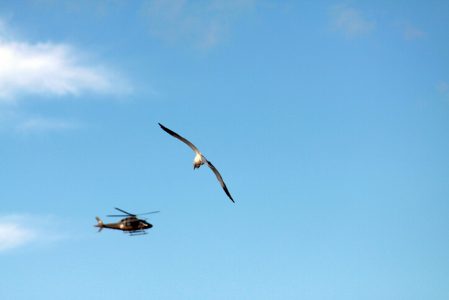Flight Plan for Birds
Attention all rotorcraft pilots: The FAA is warning you to be aware of local bird populations and their migration patterns before filing your flight plan. It’s crucial to refresh your operational knowledge to ensure safe and efficient travel. Considering this, the FAA has issued an updated alert (InFO 23005) to remind pilots of a study and its recommendations, which are just as relevant today as they were a decade ago.
The Dangers of Bird Strikes
- Bird strikes can cause significant damage to aircraft, from loss of engine power to structural damage.
- Birds are most active during certain times of the day, depending on their species and location. Pilots need to be aware of these patterns to take preventative measures.
- Some bird species are larger and more of a threat to aircraft than others. It’s important to know which species are the biggest threats in different regions.
- Altitudinal changes can help pilots reduce the risk of bird strikes. Flying at a higher altitude can make it less likely to encounter birds.
- Route optimization is another strategy for avoiding bird strikes. Pilots should consider flying around known bird habitats when possible.
- During liftoff and landing, pilots should be particularly vigilant to avoid bird strikes. These are the riskiest periods during a flight.
FAA Reminders
- One of the key recommendations is for pilots to know the activities of the bird populations in their area, considering seasonal migratory times and concentration patterns within typical flight routes. Pilots should also try to fly at higher altitudes and at slower airspeeds. The study found that 77% of bird strikes happened at speeds more than 80 knots, especially at the lower altitudes, so when you are flying low, slow down as much as practical.
- Additionally, for every 1000 feet above 500 feet AGL, there is a 32% decrease in the likelihood of hitting a bird, so the higher the better. This is even more important when flying at night, since most birds fly higher at night than during the day. The study goes on to recommend that rotorcraft crew members should wear a helmet and visor whenever possible.
- Aircraft lighting is also an important consideration. There is a definite benefit to using landing lights continuously during sunny conditions and at night, when practical. For partly cloudy conditions, use a 2-Hz pulsed mode or operate with white incandescent, high intensity discharge lights or light emitting diodes.
Following the advice of the FAA is not hard to do and is well worth the effort. If your flight plan takes you a little off course to avoid the migratory bird population, so be it. If you have to fly a little slower when low to the ground, that’s ok too. A little extra planning and review might just save the day and prevent an unpleasant bird/helicopter encounter.
RELATED CTS TRAINING










